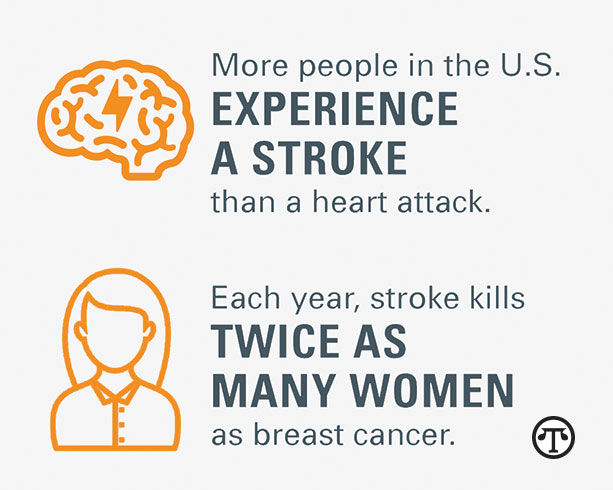(NAPSI)—In the United States, someone has a stroke every 40 secondsi, accounting for one in 20 deaths.ii A stroke occurs when a blood vessel that carries blood and oxygen to the brain is blocked by plaque or a blood clot (acute ischemic stroke) or ruptures and bleeds (hemorrhagic stroke).iii
However, the prevalence and death rates from stroke vary widely across the U.S. In eight Southern states called the “Stroke Belt,”iv the death rate from stroke is more than 20 percent higher than the U.S. average.v
While these states—North Carolina, South Carolina, Georgia, Tennessee, Mississippi, Alabama, Louisiana and Arkansasvi—are known to have a higher prevalence of stroke, anyone can be at risk wherever one lives.
There are several types of risk factors for stroke, some of which are hereditary such as heart disease, diabetes and high blood pressure.vii Others are preventable, including smoking and the use of tobacco, an unhealthy diet, excessive alcohol consumption and a lack of daily exercise.viii
Stroke risk also increases with age, but strokes can and do occur at any age.ix Compared with the 1995−99 period, the rate of stroke in 2010−14 increased by 147 percent in people 35 to 39, by 101 percent in people 40 to 44 and by 68 percent in those 45 to 49.x It’s the fifth leading cause of deathxi and kills more than 130,000 Americans each year.xii
Recognizing and understanding the signs and symptoms of a stroke is crucial. Immediate medical attention may limit the effects of a stroke, so it is imperative that people call 911 at the first sign.xiii
Always Act F.A.S.T.
If you or someone you know begins to show signs and symptoms of a stroke, there’s a four-letter acronym, “F.A.S.T.,” which corresponds to a test that can be used as a quick screening tool:xiv
• F=FACE, loss of function on one side of your face, which may look like droopingxv
• A=ARMS, sudden weakness on one side, which may mean you can’t hold the arm upxvi
• S=SPEECH, as in slurred speechxvii
• T=TIME, time to call 911.xviii
If the person shows any of these symptoms, call 911 or get to the hospital immediately. Time is brain.
To learn more about stroke, visit www.strokecall911.com.
Content sponsored by Genentech, a member of the Roche Group. Genentech is committed to stroke education and awareness.
———————————————————————————–
i Stroke Facts. Retrieved March 13, 2017 from https://www.cdc.gov/stroke/facts.htm
ii Stroke Facts. Retrieved March 13, 2017 from https://www.cdc.gov/stroke/facts.htm
iii Types of Stroke Fact Sheet. Retrieved March 10, 2017, from http://www.cdc.gov/stroke/types_of_stroke.htm
iv Heart Disease and Stroke Statistics-2014 Update. (2014). Circulation, p. e169. Retrieved March 6, 2017
v Heart Disease and Stroke Statistics-2014 Update. (2014). Circulation, p. e169. Retrieved March 6, 2017
vi Heart Disease and Stroke Statistics-2014 Update. (2014). Circulation, p. e169. Retrieved March 6, 2017
vii Who Is at Risk for a Stroke? Retrieved March 15, 2017 from https://www.nhlbi.nih.gov/health/health-topics/topics/stroke/atrisk
viii Lifestyle Risk Factors. Retrieved March 10, 2017 from http://www.stroke.org/understand-stroke/preventing-stroke/lifestyle-risk-factors
ix Stroke Fact Sheet. Retrieved March 10, 2017 from http://www.cdc.gov/dhdsp/data_statistics/fact_sheets/docs/fs_stroke.pdf
x Stroke Fact Sheet. Retrieved March 10, 2017 from http://www.cdc.gov/dhdsp/data_statistics/fact_sheets/docs/fs_stroke.pdf
xi Stroke Fact Sheet. Retrieved March 10, 2017 from http://www.cdc.gov/dhdsp/data_statistics/fact_sheets/docs/fs_stroke.pdf
xii Act FAST. Retrieved March 10, 2017 from http://www.stroke.org/understand-stroke/recognizing-stroke/act-fast
xiii Act FAST. Retrieved March 10, 2017 from http://www.stroke.org/understand-stroke/recognizing-stroke/act-fast
xiv Act FAST. Retrieved March 10, 2017 from http://www.stroke.org/understand-stroke/recognizing-stroke/act-fast
xv Act FAST. Retrieved March 10, 2017 from http://www.stroke.org/understand-stroke/recognizing-stroke/act-fast
xvi Act FAST. Retrieved March 10, 2017 from http://www.stroke.org/understand-stroke/recognizing-stroke/act-fast
xvii Act FAST. Retrieved March 10, 2017 from http://www.stroke.org/understand-stroke/recognizing-stroke/act-fast
xviii Stroke Facts. Retrieved March 13, 2017 from https://www.cdc.gov/stroke/facts.htm
On the Net:North American Precis Syndicate, Inc.(NAPSI)

